(5622 products available)













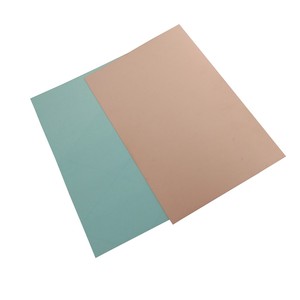


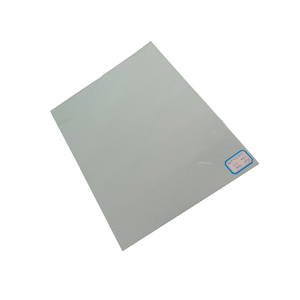

































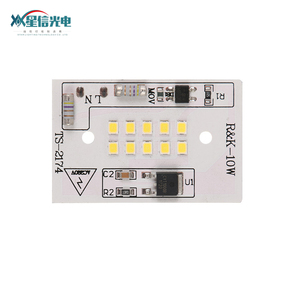


















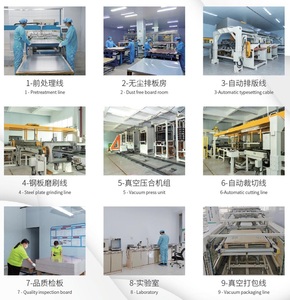







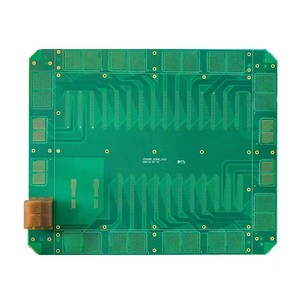





















































































































China Al LED PCBs come with several types. They include:
Standard LED PCBs
Typically, they are basic printed circuit boards that provide a foundation for LED mounting. Often, they are produced from multiple types of non-aluminum materials. Some of the materials include fiberglass (FR-4) or traditional copper-based PCBs. These standard PCBs are mostly used in basic LED lighting solutions where heat dissipation, though important, is not as critical as in high-density or high-power applications.
Multi-layer LED PCBs
Usually, these PCBs are designed to offer more complex circuit designs. Also, they provide additional functionality in more sophisticated LED systems. For instance, in signage or high-tech displays. Commonly, they contain two or more layers of aluminum substrates, which helps accommodate more intricate wiring while still providing efficient heat dissipation. The multilayer design supports advanced features such as programmable LED displays or integrated power management systems, therefore making them ideal for commercial applications.
Flexible LED PCBs
This PCB is made of an aluminum base. However, it incorporates a flexible material layer on top of it. This is to provide flexibility in application. These PCBs are widely used in situations where the lighting design needs to adapt to non-flat surfaces. For instance, in automotive interiors or curved LED displays. The combination of aluminum's cooling properties and flexibility allows for both heat management and adaptability to complex designs, hence making flexible LED PCbs ideal for innovative lighting solutions.
High-Density LED PCBs
Often, these PCBs are designed to support higher LED density per area. Then these make them suitable for high-performance applications. For instance in commercial lighting and industrial settings. Often, they feature a compact layout that maximizes space utilization, with the aluminum substrate providing effective heat sinking even under heavy usage. Because of their durability and high performance, they are preferred for applications requiring long operational hours and increased brightness.
Heat Sink LED PCBs
Usually, these boards are designed with integrated heat sink features that enhance cooling beyond standard aluminum-backed PCBs. Ideally, these can include fin designs or other heat-dissipating structures that aid in venting excess heat away from the LEDs. Therefore, this ensures prolonged lifespan and better performance. These PCBs are essential for high-powered LED systems used in industrial lighting, outdoor signage, and streetlights where heat management is a critical factor.
Electrical Conductivity
Usually, these PCBs facilitate electrical connectivity for LEDs by providing a surface where multiple components can be connected in circuit form. This enables the desired lighting effects and control functions.
Heat Dissipation
The primary function of an Al LED PCB is to manage heat generated by LEDs thus preventing them from overheating. This ensures that they operate at optimal temperatures. Therefore, their functionality includes this capability that allows for longer life expectancy and consistency in brightness, thus making an ideal option for numerous applications.
Mounting Surface for LEDs
These PCBs provide a stable platform for mounting the LED components. Therefore, this is essential in establishing a proper electrical connection and alignment for the resultant light emission.
Durability and Strength
Al LED PCBs are designed to be strong and durable. They withstand industrial settings. Ideally, this is due to their metal base, which offers greater resistance to mechanical stress compared to traditional FR-4 PCBs. Their robustness ensures long-term reliability and minimal maintenance.
Efficient Heat Management
Usually, these PCBs come with exceptional thermal conductivity. Normally, they help in the dissipation of heat away from the LED components. Therefore, this maintains optimal operating temperatures and prevents overheating. This feature enables a higher density of LEDs with no need for additional cooling components and saving space and costs in the long run.
Customizability
Often, these PCBs can be manufactured in various shapes, sizes, and configurations. This way they accommodate specific requirements. Also, manufacturers can specify their desired LED configurations, power supply design, and unique circuit layouts. This versatility lets these PCBs meet unique application requirements, be it in complex industrial machinery or bespoke commercial lighting solutions.
Increased Energy Efficiency
Ideally, these PCBs feature remarkable thermal management, which plays a crucial role in preventing energy loss as heat. This allows the LEDs to operate more efficiently as they utilize more energy for actual lighting. Therefore, with reduced heat loss, they contribute to lower electric bills and reduced carbon emissions, especially in large-scale operations.
Typically, the design of these PCBs incorporates a layer of aluminum material with excellent thermal properties. Normally, the aluminum layer is bonded to a dielectric material. Often, this forms a durable structure that supports circuit traces for electrical connections. Usually, the LED mounts directly onto the PCB. Therefore, this integrates closely between the light and the thermal management system.
Layer Structure
Usually, this design features a multi-layered setup. Normally, at its core, there is an aluminum layer, which is sandwiched between an insulating layer of material and a copper layer that forms the circuitry. Often, this multilayer design allows for efficient heat transfer from the LED through the aluminum and into the surrounding air. This is vital for keeping the LED cool and operating properly.
Circuit Trace Design
Usually, these traces are created with copper lines. Their thickness and width can be adjusted to manage power requirements. Therefore, this flexibility in design goes a long way in ensuring that the PCB will support the electrical demands of a range of LED setups. Also, this optimization prevents overheating and maintains energy efficiency in the lighting.
Surface Finish Options
Typically, the surface finish of these PCBs can be customized. This is to improve solderability and protect against corrosion. In addition, available options include gold immersion, HASL, and silver immersion. Also, each of these finishes renders unique benefits. For instance, gold immersion provides superior soldering quality. This ensures long-term reliability of the electronic connections in the LED displays.
Layer Thickness and Configuration
This design allows for the choice of aluminum layer thickness. Usually, thicker layers improve heat dissipation. Also, this is critical for applications that use high-power LEDs. Besides, manufacturers can customize the PCB in accordance with specific needs. Therefore, whether in a high-energy environment or standard commercial lighting, this adaptability ensures performance is optimized.
Industrial Lighting Solutions
These PCB are vital in industrial lighting solutions. They support high-power LED fixtures in warehouses, factories, and outdoor spaces. Usually, the robust aluminum base manages the heat produced. Therefore, it ensures the lights remain bright and efficient even in large open spaces with greater ceilings and longer operational hours.
Automotive Lighting
Normally, these PCBs are used in automotive applications. They allow LED lighting systems to conform to various shapes. This provides interior lighting, headlights, and tail lights. In such applications, the flexibility and heat dissipation properties are vital. Normally, they ensure the LEDs operate properly and efficiently within the confined spaces and the varying temperatures commonly found in automotive environments.
Signage and Display Systems
Often, LED PCBs are used in both indoor and outdoor signage. Usually, they provide the brightness and clarity needed for advertising and informational displays. The thermal management capabilities of these PCBs ensure the LED panels display consistent brightness. Therefore, this makes them visible in all weather conditions and at different times of the day.
Retail and Commercial Lighting
This PCB is common in retail and commercial spaces like offices, malls, and theaters. Usually, they provide energy-efficient lighting solutions. They are capable of supporting the ambient, accent, and task lighting. The effective heat dissipation extends the LEDs' lifespan. This lowers maintenance costs and operational downtime for the business.
Architectural and Decorative Lighting
These PCBs are used in both indoor and outdoor architectural lighting. They are integral in highlighting building features, landscapes, and artwork. In decorative lighting, they provide flexibility for designers. Besides, the efficient heat management ensures that the lights stay vibrant and functional. This does not interfere with the aesthetics of the design.
The choice of LED PCB mainly depends on several factors. Here are some of them:
Iref
The first factor business owners ought to consider is the LED type. Different LED applications require different PCBs. For instance, in commercial lighting, multilayer or standard PCBs are commonly used. At the same time, industrial and automotive lighting makes use of high-density or flexible LED PCBs. Also, the application of the PCB in question has a great impact on its design. This goes a long way in determining the specific requirements of the PCB.
Material Quality
LED PCBs are constructed using different materials. Each of these materials comes with its own benefits and drawbacks. While the main material used is FR-4, there are instances where aluminum is combined with other materials for added benefits. Therefore, business owners need to select PCBs made of materials that suit the needs of their customers. For instance, those looking for a durable and heat-resistant option are likely to benefit from aluminum PCBs.
Thermal Conductivity
Normally, this is one of the most important factors when selecting these PCBs. As highlighted earlier, these PCBs are commonly applied in areas with high thermal loads. This means that users should go for PCBs with high thermal conductivity. Ideally, it should be above 1.5 W/mk. Business owners should also ensure that the thermal resistance of the PCB is as minimal as possible.
Layer Count
These PCBs come in different layer counts. Each of these layers is suitable for different applications. Simply put, the higher the layer count, the more complex the circuit. So business owners should go for a higher count if their customers require PCBs for sophisticated applications. Retailers should also note that PCBs with a higher layer count are more expensive since they are more difficult to manufacture.
Circuit Thickness
Business owners should also consider the thickness of the circuit. Usually, thicker circuits lead to better conductivity. Further, this helps to reduce the chances of PCB warping. Consequently, shoppers should settle for thicker circuits if their customers intend to use high-powered LEDs. In general, a good PCB should have a film thickness of about 1.4mil.
There are several factors affecting the price of these PCBs. They include the number of layers, material thickness, and the complexity of the design. For instance, PCBs with more layers are likely to cost more since they are more complex to manufacture. Besides, the type of material used also affects the cost. Manufacturers who use high-quality FR-4 will sell their PCBs at a higher price than those who use standard material. Additionally, PCBs with a higher thickness value are more expensive. This is because they have greater durability and thermal conductivity. The surface finish and hole types also affect the cost of the PCB.
Yes, customers can use these PCBs for DIY home lighting. Even though these kits are geared toward professionals, they are simple enough for experts to apply in DIY projects. These kits provide endless design possibilities. Therefore, customers can easily use these kits to make unique and functional LED lighting systems for their homes.
Yes,customers can adjust these PCBs according to their specific needs. For instance, customers can request the manufacturers to cut the PCBs into unique shapes to meet branding requirements. They can also adjust the thickness and number of layers to meet specific electrical and mechanical needs. Lastly, customers have different flexibility options to cater to their specific application needs. All these customizations increase the utility of these products.
The standard and high-density LED PCBs have the same basic function. That is to provide a reliable platform for mounting LEDs. The main difference between the two types lies in the density of the circuitry. As mentioned above, high-density PCBs have more compact designs and use advanced technologies like microvias. This makes them ideal for applications with advanced features. On the other hand, standard PCBs have a lower LED count. This makes them suitable for simpler LED applications.
Yes, there are waterproof and weatherproof options available. Buyers can simply apply for these options if they intend to use the PCBs in outdoor applications, in which case they will be exposed to harsh weather conditions.